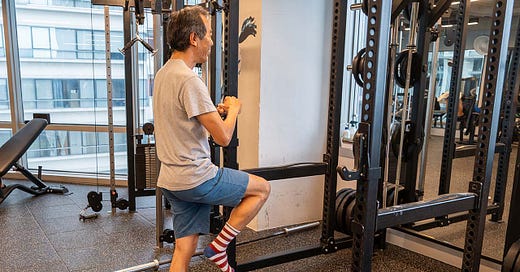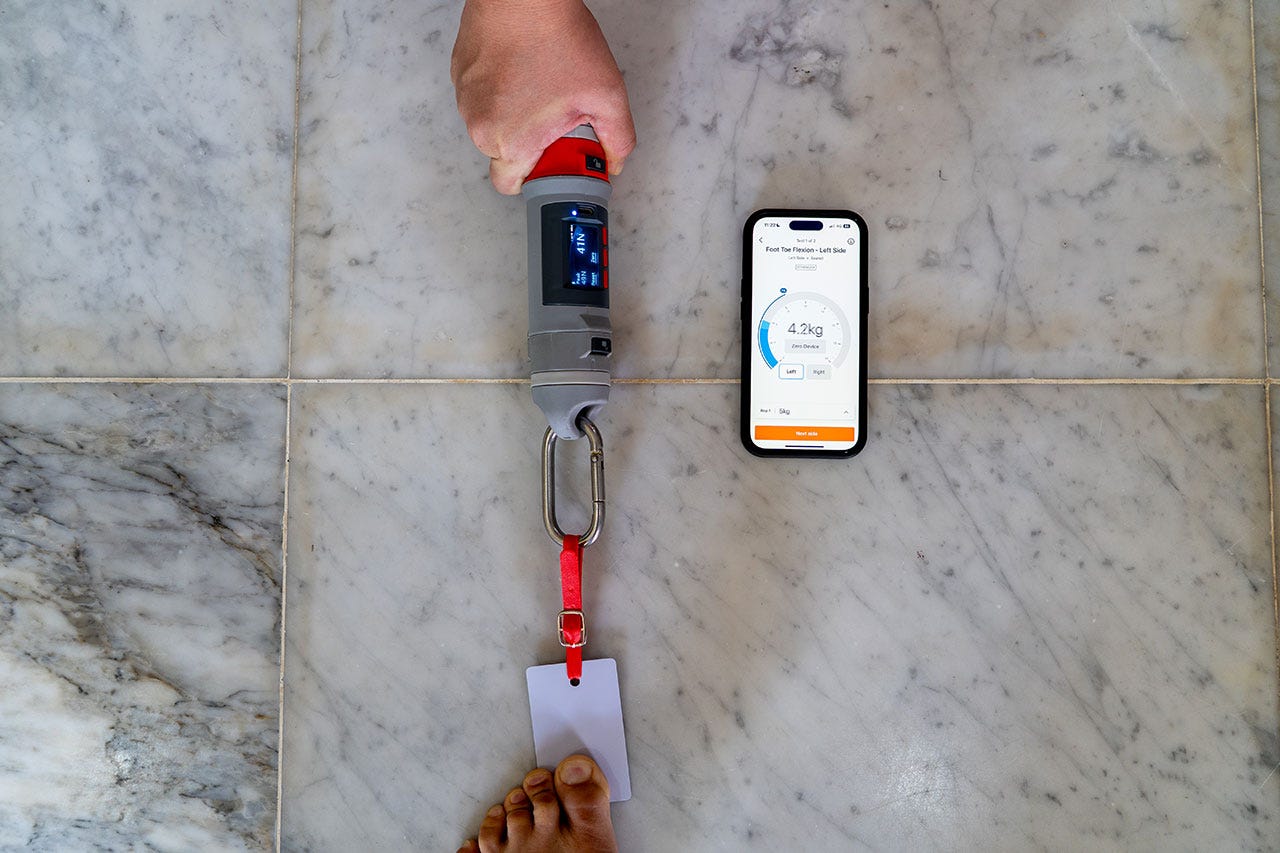What’s a Strength Assessment for Seniors Like?
Five common tests in the seniors' strength assessment battery.
I previously wrote about:
Here, I elaborate on strength assessments for seniors.
Specifically, I feature five common tests appropriate for seniors.
Sit to stand test
Grip strength test
Single leg range of stability
Big toe strength
Flexibility/biomechanics tests
At the end of the article, I’ll share a video on how you can leverage these tests for safer, more effective, and senior-targeted strength training.
Strength Assessment Equipment
Before we start, a quick disclaimer:
The article contains demonstrations from assessment equipment manufacturers, VALD, of which I am a user.
However, they are not sponsoring this article, and there are other options in the market to help conduct these tests.
The common theme among manufacturers is that the equipment’s sensors measure precise metrics, e.g. rate of force development to the millisecond, to provide actionable insights.
Sit-to-Stand Test
The sit-to-stand test uses repetition count and completion time to assess seniors’ leg strength, balance, and power.
Research shows that lower performance on this test is linked to higher risks of falls, disability, cardiovascular issues, and even mortality in older adults.
Advanced metrics possible through force deck assessments, as seen in the video above, include force production, rate of force development (RFD), limb asymmetry, depth of squat, etc.
These detailed measurements allow for further takeaways like imbalances identification, rehabilitation progress tracking, and tailored precise interventions.
Grip Strength Test
Research demonstrates that grip strength serves as a reliable indicator of overall skeletal muscle strength, bone mineral density, and general physical function.
For instance, a 2015 study found that for every 5 kg decrease in grip strength, there was a 16% increase in all-cause mortality, as well as a significant increase in risk for cardiovascular death, stroke, and heart attack.
Nationally representative reference values for hand grip strength are also available for many countries.
Locally, in Singapore, clinicians have formally incorporated grip strength testing into the diagnosis and management of sarcopenia, using the reference values from the Asian Working Group for Sarcopenia (AWGS) 2019 consensus, and local studies.
Single Leg Range of Stability
The test protocol involves standing on one foot while maintaining hands on hips and chest up, then leaning as far as possible in each direction - forwards, backwards, left, and right - without losing balance.
This test provides clinicians and practitioners with precise, quantifiable data on postural control and base of support, making it valuable for rehabilitation, fall risk assessment, and athletic performance monitoring.
Current evidence, though limited, deems the assessment as a significant advancement over traditional subjective balance assessments.
Big Toe Strength
Big toe strength measurement methods include dynamometry, shown above, and the Enhanced Paper Grip Test.
Researchers found older adults showed approximately 35-38% decreased toe strength compared to younger populations, and the reduced toe strength is linked to poorer balance and increased fall risk.
At the same time, multiple studies have demonstrated that increased toe strength significantly improves balance and reduces fall risk, particularly in older adults.
Flexibility/Biomechanics Tests
3D motion capture technology, like the VALD HumanTrak, enables clinicians to objectively assess seniors’ movement quality, range of motion, balance, and stability.
Research shows it provides reliable measurements for key movements such as shoulder abduction and flexion, as well as lower limb and trunk assessments, which are important for identifying mobility limitations and fall risk in older adults.
The system’s real-time feedback helps assessors tailor interventions and monitor rehabilitation progress with greater precision than traditional visual assessments.
Leveraging Strength Assessments for Seniors-Friendly Training
Strength assessments also enables seniors-customised training that are:
safer
less strenuous
more functionally beneficial
The above video demonstrates how my team is incorporating such testing and training for our clients.
Conclusion
There are more than a thousand strength assessments apart from those mentioned to measure different metrics, movements, and body parts.
If you would like to learn more about such exercises, my team:
conducts isometric train-the-trainer workshops
provides strength testing as a standalone service
utilise strength testing in our personal training service
Please contact us if you would like more information.
References
Andersen, J. T., McCarthy, A. M., Wills, J. A., Fuller, J. T., Lenton, G. K., & Doyle, T. L. A. (2023). A markerless motion capture system can reliably determine peak trunk flexion while squatting with and without a weighted vest. Journal of Biomechanics, 152, 111587. https://doi.org/10.1016/j.jbiomech.2023.111587
Bohannon, R. W. (2019). <p>Grip Strength: An Indispensable Biomarker For Older Adults</p> Clinical Interventions in Aging, Volume 14, 1681–1691. https://doi.org/10.2147/cia.s194543
Campitelli, A., Paulson, S., Vincenzo, J., Glenn, J. M., Gills, J. L., Jones, M. D., Powers, M., & Gray, M. (2021). Sit-to-Stand Power Across the Lifespan: A Cross-Sectional Analysis. Journal of Aging and Physical Activity, 30(4), 678–688. https://doi.org/10.1123/japa.2021-0066
Chen, L., Woo, J., Assantachai, P., Auyeung, T., Chou, M., Iijima, K., Jang, H. C., Kang, L., Kim, M., Kim, S., Kojima, T., Kuzuya, M., Lee, J. S., Lee, S. Y., Lee, W., Lee, Y., Liang, C., Lim, J., Lim, W. S., . . . Arai, H. (2020). Asian Working Group for Sarcopenia: 2019 Consensus Update on Sarcopenia Diagnosis and Treatment. Journal of the American Medical Directors Association, 21(3), 300-307.e2. https://doi.org/10.1016/j.jamda.2019.12.012
Collings, T. J., Lima, Y. L., Dutaillis, B., & Bourne, M. N. (2024). Concurrent validity and test–retest reliability of VALD ForceDecks’ strength, balance, and movement assessment tests. Journal of Science and Medicine in Sport, 27(8), 572–580. https://doi.org/10.1016/j.jsams.2024.04.014
De Brito, L. B. B., Ricardo, D. R., De Araújo, D. S. M. S., Ramos, P. S., Myers, J., & De Araújo, C. G. S. (2012). Ability to sit and rise from the floor as a predictor of all-cause mortality. European Journal of Preventive Cardiology, 21(7), 892–898. https://doi.org/10.1177/2047487312471759
Kojima, K., Kamai, D., Yamamoto, A., Tsuchitani, Y., & Kataoka, H. (2021). The effect of toe-grasping exercises on balance ability in home-based rehabilitation: a randomized controlled trial by block randomization. Physical Therapy Research, 24(3), 272–279. https://doi.org/10.1298/ptr.e10105
Lein, D. H., Alotaibi, M., Almutairi, M., & Singh, H. (2022). Normative reference values and validity for the 30-Second Chair-Stand test in healthy young adults. International Journal of Sports Physical Therapy, 17(5). https://doi.org/10.26603/001c.36432
Leong, D. P., Teo, K. K., Rangarajan, S., Lopez-Jaramillo, P., Avezum, A., Orlandini, A., Seron, P., Ahmed, S. H., Rosengren, A., Kelishadi, R., Rahman, O., Swaminathan, S., Iqbal, R., Gupta, R., Lear, S. A., Oguz, A., Yusoff, K., Zatonska, K., Chifamba, J., . . . Yusuf, S. (2015). Prognostic value of grip strength: findings from the Prospective Urban Rural Epidemiology (PURE) study. The Lancet, 386(9990), 266–273. https://doi.org/10.1016/s0140-6736(14)62000-6
Lim, W., Cheong, C., Lim, J., Tan, M., Chia, J., Malik, N., & Tay, L. (2022). Singapore Clinical Practice Guidelines for Sarcopenia: Screening, diagnosis, management and Prevention. The Journal of Frailty & Aging. https://doi.org/10.14283/jfa.2022.59
McCarthy, A., Wills, J. A., Andersen, J., Lenton, G. K., & Doyle, T. L. A. (2022). Evaluating the intra- and inter-day reliability of output measures for the VALD HumanTrak: dynamic movements and range of motion of the shoulder and hip with body armour. Ergonomics, 66(3), 406–418. https://doi.org/10.1080/00140139.2022.2092218
Mickle, K. J., Angin, S., Crofts, G., & Nester, C. J. (2016). Effects of age on strength and morphology of toe flexor muscles. Journal of Orthopaedic and Sports Physical Therapy, 46(12), 1065–1070. https://doi.org/10.2519/jospt.2016.6597
Mickle, K. J., Caputi, P., Potter, J. M., & Steele, J. R. (2016). Efficacy of a progressive resistance exercise program to increase toe flexor strength in older people. Clinical Biomechanics, 40, 14–19. https://doi.org/10.1016/j.clinbiomech.2016.10.005
Modernizing Balance Assessments with ForceDecks. (2024, October 9). https://valdhealth.com/news/modernizing-balance-assessments-with-forcedecks
Murao, Y., Ishikawa, J., Tamura, Y., Kobayashi, F., Iizuka, A., Toba, A., Harada, K., & Araki, A. (2023). Association between physical performance during sit-to-stand motion and frailty in older adults with cardiometabolic diseases: a cross-sectional, longitudinal study. BMC Geriatrics, 23(1). https://doi.org/10.1186/s12877-023-04011-z
Ong, H. L., Abdin, E., Chua, B. Y., Zhang, Y., Seow, E., Vaingankar, J. A., Chong, S. A., & Subramaniam, M. (2017). Hand-grip strength among older adults in Singapore: a comparison with international norms and associative factors. BMC Geriatrics, 17(1). https://doi.org/10.1186/s12877-017-0565-6
Quinlan, S., Yan, A. F., Sinclair, P., & Hunt, A. (2020). The evidence for improving balance by strengthening the toe flexor muscles: A systematic review. Gait & Posture, 81, 56–66. https://doi.org/10.1016/j.gaitpost.2020.07.006
Sadaqa, M., Németh, Z., Makai, A., Prémusz, V., & Hock, M. (2023). Effectiveness of exercise interventions on fall prevention in ambulatory community-dwelling older adults: a systematic review with narrative synthesis. Frontiers in Public Health, 11. https://doi.org/10.3389/fpubh.2023.1209319
Słomka, K. J., & Michalska, J. (2024). Relationship between the strength of the ankle and toe muscles and functional stability in young, healthy adults. Scientific Reports, 14(1). https://doi.org/10.1038/s41598-024-59906-7
Strassmann, A., Steurer-Stey, C., Lana, K. D., Zoller, M., Turk, A. J., Suter, P., & Puhan, M. A. (2013). Population-based reference values for the 1-min sit-to-stand test. International Journal of Public Health, 58(6), 949–953. https://doi.org/10.1007/s00038-013-0504-z
Tsekoura, M., Pantou, M., Fousekis, K., Billis, E., Gliatis, J., & Tsepis, E. (2023). Reliability and clinical applicability of lower limp strength using an enhanced paper grip strength. European Journal of Translational Myology. https://doi.org/10.4081/ejtm.2023.11841




